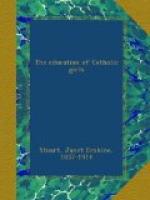CHAPTER IV.
THE ELEMENTS OF CATHOLIC PHILOSOPHY.
“E quosto ti sia sempre piombo ai piedi,
Per farti mover lento, com’ uom
lasso,
Ed al si ed al no, che tu non vedi;
Che quegli e tra gli stolti bene abbasso,
Che senza disfcinzion afferma o nega,
Nell’ un cosi come nell’ altro
passo;
Perch’ egl’ incontra che piu volte piega
L’ opinion corrente in falsa parte,
E poi l’ affetto lo intelletto lega.
Vie piu che indarno da riva si parte,
Perche non toma tal qual ei si move,
Chi pesca per lo vero e noil ha l’
arte.”
DANTE,
“Paradiso,” Canto XIII.
The elements of Catholic philosophy may no longer be looked upon as out of place in the education of our girls, or as being reserved for the use of learned women and girlish oddities. They belong to every well-grounded Catholic education, and the need for them will be felt more and more. They are wanted to balance on the one hand the unthinking impulse of living for the day, which asks no questions so long as the “fun” holds out, and on the other to meet the urgency of problems which press upon the minds of the more thoughtful as they grow up. When this teaching has been long established as part of an educational plan it has been found to give steadiness and unity to the whole; something to aim at from the beginning, and in the later years of a girl’s education something which will serve as foundation for all branches of future study, so that each will find its place among the first principles, not isolated from the others but as part of a whole. The value of these elements for the practical guidance of life is likewise very great. A hold is given in the mind to the teaching of religion and conduct which welds into one defence the best wisdom of this world and of the next. For instance, the connexion between reason and faith being once established, the fear of permanent disagreement between the two, which causes so much panic and disturbance of mind, is set at rest.
There is a certain risk at the outset of these studies that girls will take the pose of philosophical students, and talk logic and metaphysics, to the confusion of their friends and of their own feelings later on, when they come to years of discretion and realize the absurdity of these “lively sallies,” as they would have been called in early Victorian times—the name alone might serve as a warning to the incautious! They may perhaps go through an argumentative period and trample severely upon the opinions of those who are not ready to have their majors “distinguished” and their minors “conceded,” and, especially, their conclusions denied. But these phases will be outlived and the hot-and-cold remembrance of them will be sufficient expiation, with the realization that they did not know much when they had taken in the “beggarly elements” which dazzled them for a moment. The more thoughtful minds will escape the painful phase altogether.




